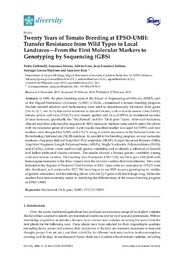Please use this identifier to cite or link to this item:
https://hdl.handle.net/11000/36016Full metadata record
| DC Field | Value | Language |
|---|---|---|
| dc.contributor.author | García Martínez, Santiago | - |
| dc.contributor.author | Carbonell, Pedro | - |
| dc.contributor.author | Alonso Sanchis, Aránzazu | - |
| dc.contributor.author | Grau Sánchez, Adrián | - |
| dc.contributor.author | Salinas, Juan Francisco | - |
| dc.contributor.author | Ruíz, Juan José | - |
| dc.contributor.other | Departamentos de la UMH::Biología Aplicada | es_ES |
| dc.date.accessioned | 2025-03-17T15:03:45Z | - |
| dc.date.available | 2025-03-17T15:03:45Z | - |
| dc.date.created | 2018 | - |
| dc.identifier.citation | Diversity 2018, 10(1), 12; | es_ES |
| dc.identifier.issn | 1424-2818 | - |
| dc.identifier.uri | https://hdl.handle.net/11000/36016 | - |
| dc.description.abstract | In 1998, the plant breeding team at the School of Engineering of Orihuela (EPSO), part of the Miguel Hernández University (UMH) in Elche, commenced a tomato breeding program. Marker-assisted selection and backcrossing were used to simultaneously introduce three genes (Tm-2a, Ty-1, and Sw-5) that confer resistance to relevant viruses, such as tomato mosaic virus (ToMV), tomato yellow curl virus (TYLCV), and tomato spotted wilt virus (TSWV), to traditional varieties of local tomatoes, specifically the “Muchamiel” and the “De la pera” types. After each backcross, cleaved amplified polymorphic sequence (CAPS) molecular markers were used to select the plants with the resistance genes of interest. A previously described marker was used for TSWV, and new markers were designed for ToMV, and TYLCV using available sequences in the National Center for Biotechnology Information (NCBI) database. In parallel to the breeding program, several molecular markers—Sequence Related Amplified Polymorphism (SRAP), Simple Sequence Repeats (SSRs), Amplified Fragment Length Polymorphisms (AFLPs), Single Nucleotide Polymorphisms (SNPs), and (GATA)4 probes—were used to study genetic variability, and to identify a collection of Spanish and Italian traditional tomato varieties. The results showed a limited genetic variability among cultivated tomato varieties. The breeding lines Muchamiel UMH 1200, and De la pera 1203 (both with homozygous resistance to the three viruses) were the first new varieties that were obtained. They were included in the Register of Protected Plant Varieties in 2013. Lines without a resistance to TYLCV were also developed, and protected in 2017. We have begun to use SNP massive genotyping for studies of genetic association, and for selecting plants with the Ty-1 gene with less linkage drag. Molecular markers have been extremely useful in identifying the different steps of the tomato breeding program at EPSO-UMH. | es_ES |
| dc.format | application/pdf | es_ES |
| dc.format.extent | 11 | es_ES |
| dc.language.iso | eng | es_ES |
| dc.publisher | MDPI | es_ES |
| dc.rights | info:eu-repo/semantics/openAccess | es_ES |
| dc.rights | Attribution-NonCommercial-NoDerivatives 4.0 Internacional | * |
| dc.rights.uri | http://creativecommons.org/licenses/by-nc-nd/4.0/ | * |
| dc.subject | De la pera | es_ES |
| dc.subject | ToMV | es_ES |
| dc.subject | TYLCV | es_ES |
| dc.subject | TSWV | es_ES |
| dc.title | Twenty Years of Tomato Breeding at EPSO-UMH: Transfer Resistance from Wild Types to Local Landraces—From the First Molecular Markers to Genotyping by Sequencing (GBS) | es_ES |
| dc.type | info:eu-repo/semantics/article | es_ES |
| dc.relation.publisherversion | https://doi.org/10.3390/d10010012 | es_ES |

View/Open:
diversity-10-00012.pdf
233,71 kB
Adobe PDF
Share:
.png)
